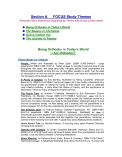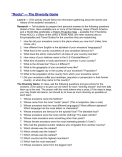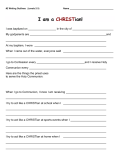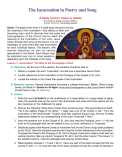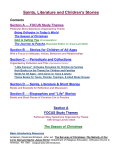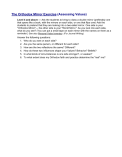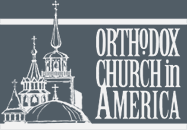My Orthodox Family
Introduction (Ages 4-6)
" For whoever does the will of My Father in heaven is My brother, and sister and mother. " - Matthew 12:50
My Orthodox Family , a parish-wide, self-study program, is designed to help us discover and develop ways we can continue to become living examples of Christ in our lives, while we help to build up society (i.e. “the world”). We are responsible for our behavior in all the communities and “families” in which we live: home, church, school, neighborhood, government, the environment, etc. Our coming together as a community in Christ is the essence of our faith. “The word church, as we remember, means a gathering or assembly of people specifically chosen and called apart to perform a particular task.” (Hopko, The Orthodox Faith II, Worship). No matter what our background, this is what binds us as Christians, and family members of His Holy Church.
The journey begins when Christians leave their homes and beds. They leave, indeed, their life in this present and concrete world, and whether they have to drive fifteen miles, or walk a few blocks, a sacramental act is already taking place, an act which is the very condition of everything else that is to happen. For they are now on their way to constitute the Church, or to be more exact, to be transformed into the Church of God. - Schmemann, For the Life of the World
As Orthodox Christians in America, we are a diverse mixture of peoples from throughout the world. Looking back on four or five generations, many of us can trace our families to immigrants from Greece, the Middle East, Russia, Central and Eastern Europe, Siberia and the Far East. Traveling long distances, our ancestors established new families and communities on the North American continent. They discovered here the same Orthodox faith that Native Alaskans had adopted in 1794 from Russian Missionaries to America. In a little over 200 years, Orthodox parishes have populated North America with more than 4-5 million people!
Our parish communities today include many new people who have found their home in the Orthodox Church. They or their ancestors have come from a multitude of nations—Irish, Italian, English, Scandinavian and German cultures from Western and Northern Europe, as well as a mixture of traditional cultures from Africa, Asia, Mexico, and South America. We not only live in multicultural societies, but in multicultural parishes in Canada, the United States, and Mexico. As Orthodox Christians in America, spending time finding out who we are and where we want to go as an Orthodox community will help us see ourselves as a part of our local, regional, national, and world communities. Along with those roles comes responsibility. Every person within the parish community has a role to play; from the newly baptized, to the oldest. How we see ourselves and our role as a Family of God is critical to the survival of the parish, as well as the entire Church in this world.
As God’s children we are called to witness our faith. We are called to understand who we are as Orthodox Christians, and to bear witness to God with our families and friends by being good neighbors, reaching out to help others, and standing up and protecting those who are being mistreated, or are victims of discrimination or prejudice. We are also called to know and live our faith; to correct misconceptions and wrong information about our beliefs, as well as to respect people of other faiths.
Overall Objectives of the Unit
Throughout the duration of this FOCUS Unit, teachers will find it helpful to keep two main overarching objectives in mind:
- Identify ourselves as Orthodox people, bound together as a family in Christian Love.
- Understand that, as faithful Orthodox Christians, we must commit ourselves to His Commandment to love one another through acts of compassion and charity to all of God’s people.
Objectives are things which the students should be able to do as a result of the session. Keeping the two main obj,ectives in mind can help us, as teachers, focus on the important fact that our parishes were established for the purposes of worship, community, mission, and good works for each other, and for those in the world around us.
God made us His People through the sacraments of the Church. We became God’s Children in Baptism. He anointed us with the Holy Oil of Chrism and called us to be His People; to hear, understand, and proclaim His Word as God’s prophets; to protect and care for the world as His anointed Kings—clothed in the white garment of Holiness; and to offer up to Him everything we are and do as a holy gift and service, as gifts offered by priests. God calls us to restore the world as the Paradise He created for His people in the Garden. He calls us to everlasting life in His Kingdom. It is through life in the Church that we become His holy people who are called to do His work in this world!
How the Unit is Arranged
The unit is comprised of six sessions of about 45 minutes each. The first five deal with identity, self-study, and involvement within our parish; while the last focuses on our involvement within our communities. The suggested prayers are just that. Singing the Troparion of the parish is certainly appropriate as an opening prayer, with the closing being whatever hymn or prayer is your parish tradition for gatherings. Students at the youngest level should probably keep the same prayers throughout the sessions for consistency.
The lessons have been developed based on five age levels: ages 4-6, ages 7-9, ages 10-12, ages 13-17, and 18-older. Every age level has its own individual lesson plan. All the lesson plans contain the following parts:
- FOCUS Unit Title, Lesson Title & Age Level
- Lesson Objectives
The lesson objectives are the things measurable by the teacher. Through questions, discussion and activity participation teachers can measure whether students were able to fulfill these objectives. If they cannot, teachers will know that review or repetition may be necessary.
- Materials
Materials are the various items required to teach the lesson. These include items such as craft materials and classroom Bibles. - Resources
Resources are items the DCE has provided for use while teaching the lesson. These include printable icons, line drawings, handouts, liturgical texts, Bible stories, planning worksheets and many other kinds of professionally developed teacher resources to aide in teaching the lesson. The resources have been categorized into two groups: Required Resources and Supplemental Resources. Required resources are specifically referred to within the lesson plan. Supplemental resources are generally useful in gathering background information. Often, the supplemental resources will be links to external web sites and suggested books for the teacher to read. - Lesson Procedure
This is a step-by step outline of how the session should go. Please be aware that some lessons require advance preparation--read lessons, prepare for them, and think prayerfully about them well before you meet students in the classroom.
Every Family Has a Story (Ages 4-6)
Overview
Family Is Love
- Every family’s story is different and each generation tells a different story about their ways of life, their joys, and their hardships.
Objectives
By the end of this Lesson, learners should be able to:- Hear stories about families and their lives together
- Compare stories with their own family lives
- Identify family members from pictures
- Draw/paste pictures of family members on a page as the beginning step to a unit scrapbook
- Recall and orally share family/ancestor story with class
- See themselves as part of the family
- Give examples of how their family loves them
- Connect God’s love with the people who love us
Materials
- 9x12 construction paper (3 per student)
- 8.5x11 white lined paper (1 per student)
- 6' Yarn strips (3 per student)
- Rounded Scissors (optional to fit photos)
- Glue Sticks
- Crayons
- Pencils
- Washable Markers
- Paper Hole Punch
- Icon for prayer
- Family Pictures
Family Members, Special Occasions, Holidays, Vacations, Baptism - Written Ancestor Story
Resources
Required Resources
- Family Scrapbook (HTML)
- My Orthodox Family - Family Letter (HTML)
- A Picnic in October (Image)
- Love You Forever (Image)
- Something to Remember Me By (Image)
Procedure
| 1 |
Opening Prayer |
In the Name of the Father, and of the Son, and of the Holy Spirit. Amen. |
| 2 |
Discussion Starter |
Begin by asking the following questions, allowing time for each student to answer:
|
| 3 |
Story |
Share one of the suggested stories listed, or one of your choice. You could also read portions of one or two stories to build upon background discussion. Ask students if they can recall the persons in the families described in the story. Note: You may skip this step, if your time is limited. |
| 4 |
Family Scrapbook |
| An activity that will enable the students to create a Family Scrapbook. |
| 5 |
Wrap-Up |
|
| 6 |
Closing Prayer |
| O Lord, save Thy people, and bless thine inheritance. Grant victories to the Orthodox Christians over their adversarie; And by virtue of Thy cross, preserve Thy habitation. In the Name of the Father, and of the Son, and of the Holy Spirit. Amen |
| 7 |
Extra Activity - Life-Sized Figures |
| Extra Activity (for use with extra/extended sessions)
Note: With younger children, you will need assistance to keep them busy while figures are measured, cut, and outlined. At least one other person will be needed to assist in these tasks while another is working on another activity (see above)
|
Life Together as a Family (Ages 4-6)
Overview
Family Means Belonging
- Families share everything; love, joy, good times and bad. They help and support one another, both physically and spiritually.
Objectives
By the end of this Lesson, learners should be able to:- Identify families as cooperative, supportive, sharing.
- List what we do at home to help other members of our family.
- Describe/explore, elaborate on what it means to belong to a family.
- Connect belonging to a family with belonging to different groups (parish, church school, activities, sports, school)
Materials
- Sheets of white or colored construction paper (9x12”) with holes punched (1 per student)
- Pictures cut from magazines/catalogs/newspapers showing families, activities (swimming, playing games, reading books, board-games, toys, schools/schoolwork, laundry, cleaning and garden tools, …)
- Copies of photos showing family members doing things together
- Scissors, paste/glue, markers/ crayons
- Board, dryboard, butcher paper
- Chalk, dry markers, markers
- Copies of family pictures depicting activities
- 3 small personal items
- Stories for children about families and cooperation (see in Teacher Resources-Tools: Saints, Literature and Children’s Stories, for summaries), choose one you feel reflect families, relationships, and interaction.
- Icon for prayer
Resources
Required Resources Optional Resources
- Bravo, Maurice! (Image)
- Families are Different (Image)
- The Keeping Quilt (Image)
Procedure
| 1 |
Opening Prayer |
In the Name of the Father, and of the Son, and of the Holy Spirit. Amen. O Heavenly King, the Comforter, the Spirit of Truth |
| 2 |
Discussion Starter-Bridge |
Begin by reviewing last week’s session. Activate prior knowledge by asking students, Who can tell me what they love about their family? (Allow time for students to share.)
|
| 3 |
Story |
Share one of the stories listed, or one of your choice. You may also read portions of one or two stories to build upon background discussion. Ask students if they can recall the persons in the families described in the story. |
| 4 |
Family Memories Scrapbook |
In Advance: Place materials close by for easy distribution to students.
|
| 5 |
Game: "Whose Is This?" |
Have students’ 3 small items placed around the room (Note: In advance, keep track of items by writing child’s initials on small labels and sticking them to an inconspicuous spot on items.). Have children walk around the room, hold up an item and each make one guess as to who owns it. The owner cannot say it belongs to him or her until the class is stumped. |
| 6 |
Wrap up |
| 7 |
Closing Prayer |
O Lord, save Thy people and bless Thine inheritance. |
God’s Story and God’s People (Ages 4-6)
Overview
When God Created People, He Created Family
- Some were faithful, and others were not. God sent leaders and prophets and, finally, His Son, Jesus, to show us how to love and help one another.
Objectives
By the end of this Lesson, learners should be able to:- Identify families from the Bible
- Recall a specific fact or incident that happened in a Bible story
- Share stories of faithfulness and love in families
- Discuss the meaning of turning away from God and why this is hurtful to us as people of God
- Compare families from the Bible with their own families
- Illustrate a story about Biblical families
- Design a mural of family Bible stories to be ongoing throughout unit
Materials
- Plain white drawing/construction paper (9 x 12”) , one per student, with holes punched
- Crayons, washable markers
- Large foam board for Bible family stories
- Colored construction paper
- Plain white drawing paper without holes
- Glue
Resources
Required Resources
- Adam and Eve disobey God (PDF)
- God blesses Hannah with a son (PDF)
- God makes a promise to Abraham (PDF)
- God takes care of a baby (PDF)
- King Solomon builds the temple (PDF)
- Two Brothers: Cain and Abel (PDF)
Procedure
| 1 |
Opening Prayer |
In the Name of the Father, and of the Son, and of the Holy Spirit. Amen. O Heavenly King, the Comforter, the Spirit of Truth |
| 2 |
Discussion Starter-Bridge |
|
| 3 |
Bible Stories |
|
| 4 |
Family Memories Scrapbook and Class Mural |
|
| 5 |
Wrap up |
Ask students to recall who their favorite Bible person was and why. Ask if they thought the families in the Bible stories were part of God’s faithful people. Have student apply what they have learned by asking, How are our families like the ones we talked about from the Bible? (Allow students to elaborate) |
| 6 |
Optional-Take Home |
| God Loves Us , Take Home Numbers 10,16 [OCEC, 1.800.464.2744] |
| 7 |
Closing Prayer |
O Lord, save Thy people and bless Thine inheritance. |
Members of God’s Family (Ages 4-6)
Overview
We Become Members of God’s Family When We Are Baptized
- Just as our families have stories, our church family has stories about how it began, where its people came from, how it grew, and important events and special times.
Objectives
By the end of this Lesson, learners should be able to:- Identify and name members of their parish (priest, deacon, church school teachers, classmates, choir members, and others they may know)
- Relate names and photos of the leaders and groups in their local church family to roots of a Family Tree that provide strength and support to the church school and parish as a true community in Christ
- Use photos to construct a Family Tree consisting of their immediate families, parish and church school family
- Relate those in their immediate families with their church family through the roots and branches of the Family Tree
Materials
- Large (12’’ x 18”) sheets of green construction paper, pre-cut into large, wide, bushy shapes. 1-2 per student, for the tree top
- Several large (12" x 18”) sheets of brown construction paper for tree trunk and roots
- Strips of brown and black crepe paper
- Copies of family pictures (several per child)
- Plastic round tops from small containers, plastic glasses, or any item which can be used to trace circles (1 ½ - 2” in diameter, graduated sizes)
- Pencils
- Rounded or blunt scissors
- Paste, glue, or glue sticks
- Sheet of small 1-1 ½” wide white stickers
- Copies of parish photos of parishioners from past generations
Resources
Required Resources
- Adam and Eve disobey God (PDF)
- God makes a promise to Abraham (PDF)
- How Noah Obeyed God (PDF)
- King Solomon builds the temple (PDF)
- "Roots" Coffee Hour Parish Event (PDF)
Procedure
| 1 |
Opening Prayer |
In the Name of the Father, and of the Son, and of the Holy Spirit. Amen. O Heavenly King, the Comforter, the Spirit of Truth |
| 2 |
Discussion Starter-Bridge |
|
| 3 |
Teaching Pics, Parish Photos |
Have students look at various pictures in Teaching Pics (OCEC). Show them pictures of the priest, deacon, altar boys, children in processions. Ask students to identify who is in the pictures (i.e. priest, deacon, altar boys, children in procession, choir, etc.). Using parish photos, repeat the process in the same manner. |
| 4 |
Family Tree |
| Print out Family Tree Activity from Teacher Resources-Activities. This project can be used as a display in the church school room, parish hall, or designated area for unit project displays. [See Teacher Resources-Activities: Roots Coffee Hour ] |
| 5 |
Wrap up |
| 6 |
Optional Take Home |
Together with God , #1, “God’s Family” [OCEC 1.800.464.2744] |
| 7 |
Closing Prayer |
| O Lord, save Thy people and bless Thine inheritance. Grant victories to the Orthodox Christians over their adversaries; And by virtue of Thy Cross, preserve Thy habitation. In the Name of the Father, and of the Son, and of the Holy Spirit. Amen. |
God Calls Us To Love All People (Ages 4-6)
Overview
Being an Orthodox Christian in a Parish Family
- Being Christian and being Orthodox should tell us who we are as right believers who celebrate our faith, and respond to those in our parish family, our community, and to those around us.
Objectives
By the end of this Lesson, learners should be able to:- Describe how they become members of the parish and larger church through Baptism
- Learn the name of their parish, and the feast or saint for whom it was named
- Draw and explain what parish members do together in church (pray, sing, light candles, listen to the Gospel, receive Holy Communion, take part in processions, etc.)
- Describe favorite family holidays and/or celebrations
- Explain the connection between home celebrations and church feasts
- Compare family and church celebrations with those of their friends and neighbors
Materials
- Cardboard or foam poster board for backing
- Several large pieces of colored poster board to cut out as frames
- Several large pieces of colored construction paper
- Drawing paper (8 ½” x 11”)
- Crayons, washable markers, pencils
- Rounded/blunt scissors
- Copies of students’ Baptism pictures
- Copies of student family celebration pictures
Procedure
| 1 |
Opening Prayer |
In the Name of the Father, and of the Son, and of the Holy Spirit. Amen. |
| 2 |
Discussion Starter-Bridge |
Begin by pointing to the Family Tree and asking, Who can tell me what this is? (Allow time for students to recall.)
|
| 3 |
Church Family Collage |
Note: You may need several adults to assist in this project.
|
| 4 |
Wrap up |
| Ask: What do we like best about being in church? Why? What things can we do help make our parish even better? (Answers should reflect what they’ve learned about belonging to a family; clean up after ourselves, be kind to others, help other people who need assistance, cooperate, share, etc.) |
| 5 |
Optional-Take Home |
| New Life in Jesus , Take Home Numbers 2,4 (OCEC, 1.800.464.2744) |
| 6 |
Closing Prayer |
| O Lord, save Thy people and bless Thine inheritance. Grant victories to the Orthodox Christians over their adversaries; And by virtue of Thy Cross, preserve Thy habitation. In the Name of the Father, and of the Son, and of the Holy Spirit. Amen. |
The Work of God's People (Ages 4-6)
Overview
We Are Accountable To God For Our Lives And Those Around Us
- As Orthodox Christians, we reveal our commitment to God through our steadfastness, integrity, compassion, and responsibility for all of God’s people.
Objectives
By the end of this Lesson, learners should be able to:- Identify the love of family, parish family and those around us as a part of Gods plan
- Describe ways we respond to Gods call as caring Orthodox Christians
- Name and practice ways to show kindness and be helpful to family, neighborhood, parish and school
- Plan to do something nice for a family member, classmate, neighbor, parishioner
- Plan to assist a person in need by preparing gifts, bringing flowers, sharing a favorite dessert, or take a nice card or homemade item to a neighbor who lives alone
Materials
- Large roll of of brown butcher paper, brown packing wrap, or bulletin board paper (get this at teacher supply or art supply store)
- Colored construction paper pre-cut into 5”-6” tall by 3”-4” wide leaves (green, orange, yellow, red, brown). If students are able, make several patterns from cardboard for then to trace and cut out themselves
- Rounded/blunt scissors
- Black crayons, washable markers
- Scotch Tape
Resources
Optional Resources
- The Resource Handbook (Link)
- God Loves Us, Take Home #21 (Book)
- Little Falcons (Book)
- Small Acts of Kindness (Image)
- The Christmas Miracle of Jonathan Toomey (Image)
Procedure
| 1 |
Opening Prayer |
In the Name of the Father, and of the Son, and of the Holy Spirit. Amen. |
| 2 |
Discussion Starter-Bridge |
Begin by pointing to the Church Family Collage Poster. Ask: Can anyone tell me what this is? (Allow time for students to recall and respond.) Ask students to step up, one or two at a time, point out, and identify some of the pictures and drawings.
|
| 3 |
Story |
Share a story from one of the above choices, or one you have chosen with the theme of helping and giving to others.
|
| 4 |
Caring Tree |
Make an outline of a tree on a large wall, with a trunk and empty branches.
|
| 5 |
Wrap up |
Ask students to point out some of their leaves and describe what some of them say.
|
| 6 |
Optional-Take Home |
God Loves Us, Take Home #21 [OCEC, 1.800.464.274] |
| 7 |
Closing Prayer |
| O Lord, save Thy people and bless Thine inheritance. Grant victories to the Orthodox Christians over their adversaries; And by virtue of Thy Cross, preserve Thy habitation. In the Name of the Father, and of the Son, and of the Holy Spirit. Amen. |

